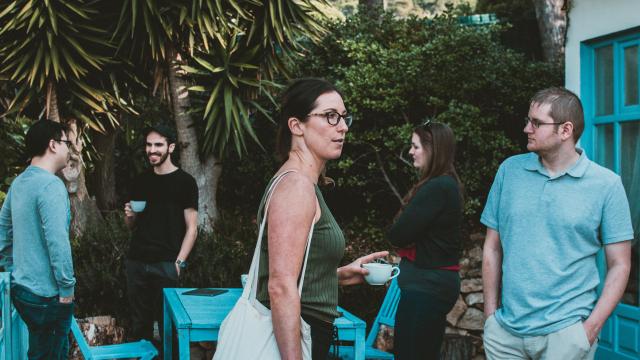Three years ago, after leaving a job and with (very) little to do, I used part of my savings on an improv class at Upright Citizens Brigade. By all accounts, I was not very funny or quick. I also couldn’t stop sweating and most people in my class thought I’d dunked my head in the sink during breaks (they weren’t wrong).
I had wanted to do the class simply to get out of my conversational funk. Unless I’ve had a drink or two, I can find small talk difficult. Meeting and talking to strangers is not a strength of mine and I often find myself backtracking through conversations, wondering where I went wrong.
[referenced url=”https://www.lifehacker.com.au/2018/08/why-you-should-get-good-at-small-talk/” thumb=”https://i.kinja-img.com/gawker-media/image/upload/t_ku-large/y0w6woqdjlpmmqw963ey.jpg” title=”Why You Should Get Good At Small Talk” excerpt=”Small talk gets a lot of backlash; most people seem to think they’re too important to discuss the weather. It’s true that some small talk can feel shallow or boring, but it serves an important purpose. That’s why everyone should learn how to do it well.”]
That said, over the years and through countless wedding invitations, job interviews, and other social gatherings, I’ve learned to hold a conversation without the occasional lulls that creep into dialogue with strangers. Thanks to Quartz (and Rob Walker, by way of his latest newsletter), I’ve assembled some of the best tips to getting over the awkward hump of small talk and why opening up is key to getting through the conversational madness:
Find a Common Ground
As Quartz mentioned, there’s the “triangulation” approach to small talk (named by Kio Stark, author of When Strangers Meet). This method involves three points: you, your partner, and the observable thing in front of you—in other words, your common ground.
It’s simple. Find the thing that ties you together and bond over it, even if it’s right in front of your eyes. The weather’s terrible! I can’t wait for lunch! Not again, Trump!
[referenced url=”https://www.lifehacker.com.au/2018/05/the-secret-to-a-captivating-dinner-party-conversation/” thumb=”https://i.kinja-img.com/gawker-media/image/upload/t_ku-large/lom5se4uyuahepu6nxwf.jpg” title=”The Secret To A Captivating Dinner Party Conversation” excerpt=”Dinner parties are often a mishmash of different people coming together under one roof for refreshing drinks and a tasty, home cooked meal. Because of that, conversations can be nothing but awkward explanations of what everyone does for a living. Lame! Kick things off this way instead.”]
If you find yourself in need of a date idea, don’t disregard the standard movie and dinner. You’ve just spent two hours together watching a film, it’s the perfect thing to create a dialogue over, even if the movie stunk (bond over the terrible acting!).
Yes, And…
There’s a cardinal rule of improv and one that Tina Fey speaks of in her book, Bossypants: the rule of “Yes, and…” Without butchering it, it means you accept the premise (conversation, in this case) as is, and you add to it without hesitation, so the improvisation can continue.
Fey captures it best:
“If we’re improvising and I say, ‘Freeze, I have a gun,’ and you say, ‘That’s not a gun. It’s your finger. You’re pointing your finger at me,’ our improvised scene has ground to a halt. But if I say, ‘Freeze, I have a gun!’ and you say, ‘The gun I gave you for Christmas! You bastard!’ then we have started a scene because we have AGREED that my finger is in fact a Christmas gun.”
Using this rule, agree with the premise and allow one answer to feed into another question or response. The weather’s terrible! Yes, and I couldn’t leave my home because I nearly drowned! Congratulations, you’ve opened up a whole new conversation (and set of urgent follow-up questions).
Talk About Yourself
One exercise from improv 101 involves speaking about a subject for a minute, uninterrupted. For a minute, you are a hamster spinning on its wheel, going on about everything from the lack of windows in the room around you to the intimate details of your personal life.
Now, I’m not saying you should speak for a minute, uninterrupted. You’ll get a lot of blank stares and perhaps a few runaways. What I’m trying to say is that when a conversation gets dry, or you’re in an exchange with someone who’s averse to small talk, don’t be afraid to talk about yourself. Sometimes, people just want to listen, and other times, people just need you to open up in order to develop a rapport.
[referenced url=”https://www.lifehacker.com.au/2018/05/how-to-really-listen-in-conversations/” thumb=”https://i.kinja-img.com/gawker-media/image/upload/t_ku-large/mvnageyj3qivyes64kdn.jpg” title=”How To Really Listen In Conversations ” excerpt=”Listening: the poor man’s talking. But your turn to pay attention to someone else’s blah blah will come. Here’s how to be the kind of listener you’d like to talk to.”]
Don’t be afraid to talk about your weekend plans, no matter how seemingly dull (I did nothing this weekend, but I finally got around to starting Game of Thrones for the first time. The number of conversations this has opened up has been unsurprising).
People want to hear what you want to say, so give yourself a pat on the back and open up. It’s easy to over-analyse every word and misstep, but don’t let that take away from your ability to have a good, light-hearted conversation.

Comments